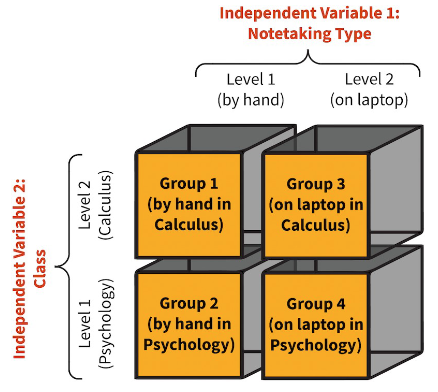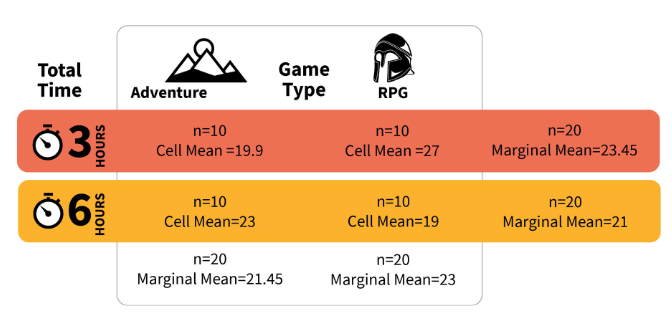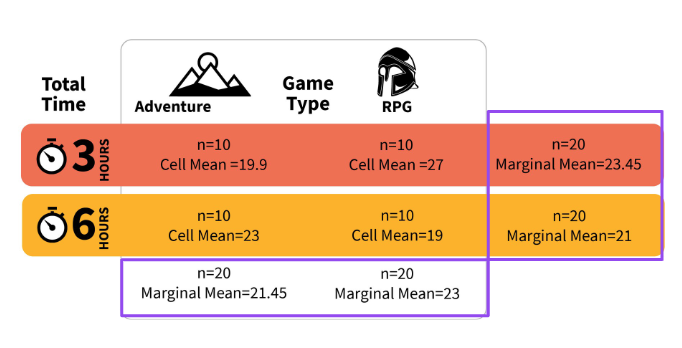(copy) Module 11 - Complex Experimental Designs
1/16
Earn XP
Description and Tags
Name | Mastery | Learn | Test | Matching | Spaced |
|---|
No study sessions yet.
17 Terms
Basic Experimental Designs
One independent and one dependent variable
Complex Experimental Designs
Multiple variables
Factorial designs: multiple independent variables
Multivariate designs: multiple dependent variables
Factorial Designs
Multiple independent variables
When it’s this design, tells you that the predictors are categorical
In a study you have a drug X drug Y and a placebo
Those are categories
The reason we would have a study
with multiple predictors is almost always because we think that, the effect of one of the predictors on the outcome might depend on what's happening with the other predictor
Has main and interaction effects
Multivariate Designs
Multiple dependent variables
2 x 2 Between-subjects Factorial Design
Two independent variables in the same study
Different participants in the various conditions
4 groups
(# x #) # refer to the number of levels in each factor

Example of a Factorial Design
How does playing video games influence cognitive functioning?
IV#1: Game type (Adventure vs. RPG)
IV#2: Time played (3 hrs vs. 6 hrs)
Confirmatory hypotheses:
The researcher specifies what effects they expect to find
Exploratory hypotheses:
The researcher does not specify what results will be found
You think there's something about the effect of one of them might differ, depending on the other one
Confirmatory/Directional Hypotheses
The researcher specifies what effects they expect to find
You have a very specific effect that you think you’re gonna find
Exploratory Hypotheses
The researcher does not specify what results will be found
I think, there might be interaction between these 2 predictors, But I'm not sure what it's gonna be
An Example of a Factorial Design: Contingency Table
Factorial designs have main effects and interaction effects
This shows cell means and marginal means

Main Effects in Factorial Designs
Compare all differences between levels of one independent variable across levels of the other
When we just isolate the effect of one of the predictors
Just comparing the rpg game vs the adventure game (ignoring time spent playing)
Or just comparing playing for 3hrs vs playing for 6hrs (ignoring the type of game that was played)

Interaction Effects in Factorial Designs
Combined Effects of independent variables
An effect of one IV on the DV depending on the level of the other IV
Describing main effects in reference to each other
There's a different effect of the game depending on this other variable here
Example: Ice Cream Preference
Ice cream you prefer on its own
= Main Effect
Preference for what ice cream you want, depending on what you're having (with Pie)
________ ________
Other Variations of Factorial Designs (Specifically 2×3)
More than two levels for the independent variable
A main effect does not clarify which levels differ
Post-hoc tests:
Allow researchers to compare the means of the levels of the IV

Post-Hoc Tests
Allow researchers to compare the means of the levels of the IV
Higher-Order Factorial Designs
Have additional main effects and interactions
A design with three or more independent variables (2×2×2)
2 (three hours versus six hours)
x 2 (adventure versus RPG)
x 2 (low versus high delay of gratification) design has six conditions

Repeated Measures Complex Designs
Participants are exposed to all levels of the independent variable
Increased statistical power
Be wary of order effects, interference effects, fatigue, and other confounds
The same group of participants take part in all of the conditions

Mixed Designs
Includes between-subjects and repeated-measures design features
Example:
We randomly assign participants to study in either a re-reading or retrieval practice condition and have all participants take a test in a hot and cold room.
This is a 2 (Between factor: re-reading or retrieval practice study method) x 2 (Within factor: hot and cold room temperature) between-within mixed design
Best Practices in Open Science: How Many Participants Do We Really Need?
Complex designs require more participants for appropriate power
Interaction effects require more participants than main effects
Smaller effects require more participants
Researchers should focus on conducting larger, well-powered studies